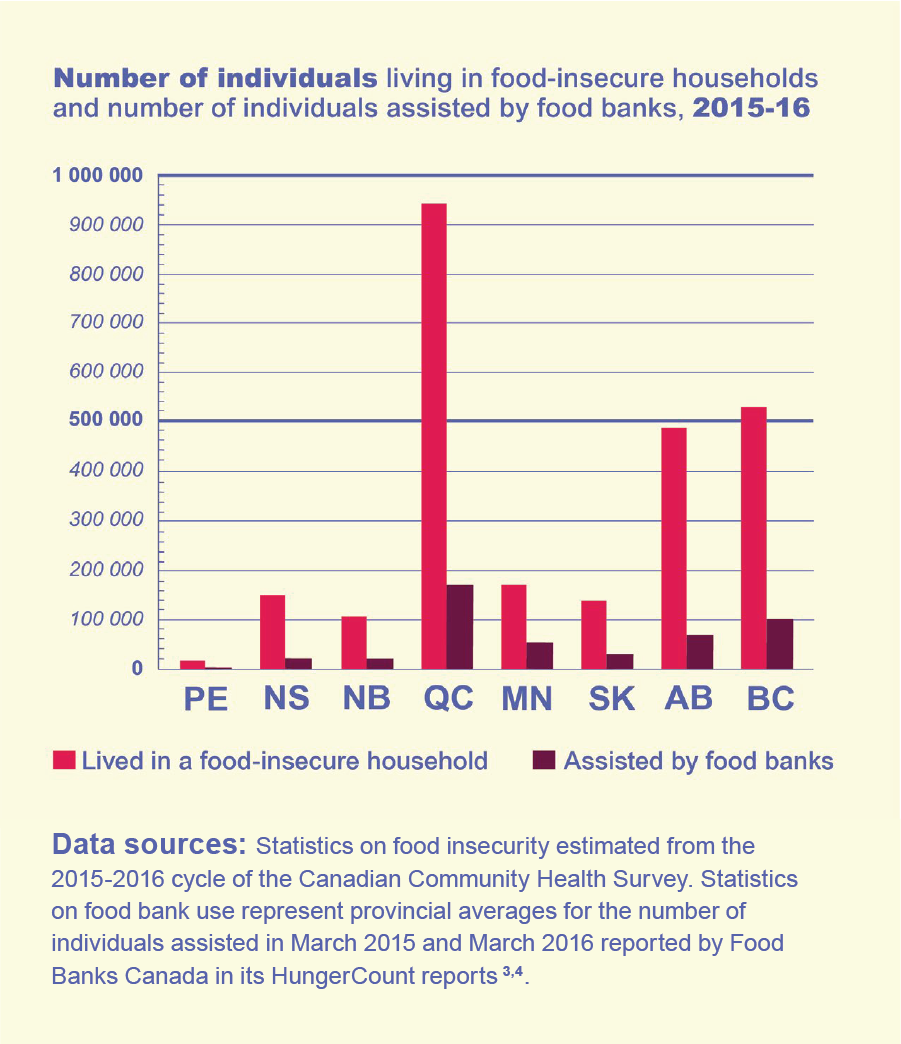Relationship Between Food Banks and Food Insecurity in Canada
November 14, 2019
Food insecurity – the inadequate or insecure access to food due to financial constraints – is monitored by Statistics Canada through the Canadian Community Health Survey. Based on the most recent national estimates from 2012, over 4 million Canadians are living in food-insecure households. Food insecurity is a serious public health problem in Canada because it negatively impacts physical, mental, and social health, and costs our healthcare system considerably.
Despite widespread recognition that food insecurity is first and foremost an income problem, policy responses in Canada have focused on food provision, with an emphasis on strengthening the charitable food sector.1
The comparison of national statistics demonstrates a substantial disconnect between the number of people living in a food-insecure household versus those accessing a food bank.2 In 2012, there were 5 times more people living in a food-insecure household than those accessing a food bank.2 More recent data from provinces that measured food insecurity in 2015 – 2016 suggests that this large disconnect persists, with a 3- to 7-fold difference between the two statistics.

Using data from nearly 1,600 households living in New Brunswick, Ontario, Quebec and Saskatchewan, a recent study examined how common using a food bank is among households experiencing a severe level of food insecurity2. The results showed that most severely food-insecure households did not report accessing a food bank. Food bank use was one of the least common strategies employed by severely food-insecure households when they were short of money. These households were much more likely to ask for financial help from friends or family and to miss bill payments. This suggests that most people who are struggling with severe food insecurity do not see food banks as a solution to their problem.

While using a food bank may provide temporary food relief for those who access these programs, there is no evidence that food banks are a solution to the very serious problem of food insecurity in Canada. Research suggests that increasing the economic resources of low-income households reduces food insecurity,5, 6, 7, 8, 9 providing a foundation for effective, evidence-based policy responses to this problem. Given the scale of the problem of food insecurity in Canada, governments’ continued focus on improving and expanding food banks as a primary response to food insecurity is ill-founded.

References:
- McIntyre L, Lukic R, Patterson PB, Anderson LC, Mah CL. (2016) Legislation debated as responses to household food insecurity in Canada, 1995-2012. Journal of Hunger & Environmental Nutrition, 11(4): 441-455. https://www.tandfonline.com/doi/full/10.1080/19320248.2016.1157551
- Tarasuk V, Fafard St-Germain AA, Loopstra R. (2019) The relationship between food banks and food insecurity: insights from Canada. Voluntas. https://link.springer.com/article/10.1007/s11266-019-00092-w
- Food Banks Canada. HungerCount 2015. https://www.foodbankscanada.ca/Hungerin-Canada/Research/HungerCount-2015.aspx
- Food Banks Canada. HungerCount 2016. https://www.foodbankscanada.ca/Hungerin-Canada/Research/HungerCount-2016.aspx
- Loopstra, R., Dachner, N., & Tarasuk, V. (2015). An exploration of the unprecedented decline in the prevalence of household food insecurity in Newfoundland and Labrador, 2007–2012. Canadian Public Policy, 41(3), 191-206. https://www.utpjournals.press/doi/abs/10.3138/cpp.2014-080
- Li, N., Dachner, N., & Tarasuk, V. (2016). The impact of changes in social policies on household food insecurity in British Columbia, 2005–2012. Preventive Medicine, 93, 151-158. https://www.sciencedirect.com/science/article/pii/S0091743516303048
- McIntyre, L., Dutton, D.J., Kwok, C. et al. (2016). Reduction of food insecurity among low-income Canadian seniors as a likely impact of a guaranteed annual income. Canadian Public Policy, 42(3), 274-286. https://www.utpjournals.press/doi/abs/10.3138/cpp.2015-069
- Ionescu-Ittu, R., Glymour, M.M., & Kaufman, J.S. (2014). A difference-in-differences approach to estimate the effect of income-supplementation on food insecurity. Preventive Medicine, 70, 108-116. https://www.sciencedirect.com/science/article/abs/pii/S0091743514004605
- Tarasuk V, Li N, Dachner N, Mitchell A. (2019). Household food insecurity in Ontario during a period of poverty reduction, 2005-2014. Canadian Public Policy, 42(1), 93-104. https://www.utpjournals.press/doi/abs/10.3138/cpp.2018-054

